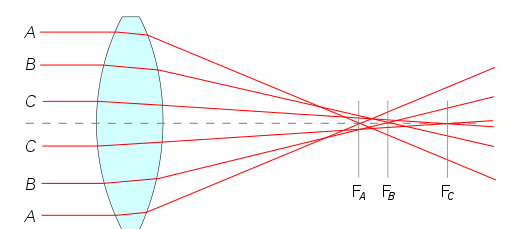
Spherical aberration in a thin lens can be reduced by.
Answer
449.7k+ views
Hint: Spherical aberration is a form of aberration that occurs in optical structures with elements that have spherical surfaces. Since this form is simpler to produce, lenses and curved mirrors are prime examples.
Complete answer:
After travelling across a spherical surface, all incoming light rays end up focused at various locations, which is known as spherical aberration. Light rays travelling through a lens on the horizontal axis are refracted less than rays passing through the lens closest to the side or "periphery," resulting in varying locations around the optical axis. In other words, after going through the prism, the parallel light rays of incoming light do not intersect at the same place. Spherical Aberration can impair resolution and visibility as a result, making it difficult to obtain sharp images.

The tendency of a lens to cover marginal rays of the same wavelength to the focus as it converges the paraxial rays causes spherical aberration; this flaw can be corrected by blocking marginal rays. A circular annular mask may be placed over the lens to do this.
The spherical aspect of the lens causes spherical aberration.
The lens's paraxial and marginal rays are centred at various points along its axis. As a result, the picture is distorted. This aberration may be minimised by either stopping paraxial or marginal rays with a circular annular label placed over the lens.
Note: As a result, the highest focus point with the smallest circle of doubt is right on this focal point. Since a standard spherical lens design does not enable the above to happen, manufacturers have created advanced, accurate methods to reduce the impact of spherical aberration over time.
Complete answer:
After travelling across a spherical surface, all incoming light rays end up focused at various locations, which is known as spherical aberration. Light rays travelling through a lens on the horizontal axis are refracted less than rays passing through the lens closest to the side or "periphery," resulting in varying locations around the optical axis. In other words, after going through the prism, the parallel light rays of incoming light do not intersect at the same place. Spherical Aberration can impair resolution and visibility as a result, making it difficult to obtain sharp images.

The tendency of a lens to cover marginal rays of the same wavelength to the focus as it converges the paraxial rays causes spherical aberration; this flaw can be corrected by blocking marginal rays. A circular annular mask may be placed over the lens to do this.
The spherical aspect of the lens causes spherical aberration.
The lens's paraxial and marginal rays are centred at various points along its axis. As a result, the picture is distorted. This aberration may be minimised by either stopping paraxial or marginal rays with a circular annular label placed over the lens.
Note: As a result, the highest focus point with the smallest circle of doubt is right on this focal point. Since a standard spherical lens design does not enable the above to happen, manufacturers have created advanced, accurate methods to reduce the impact of spherical aberration over time.
Recently Updated Pages
Master Class 12 Biology: Engaging Questions & Answers for Success

Master Class 12 Physics: Engaging Questions & Answers for Success

Master Class 12 Economics: Engaging Questions & Answers for Success

Master Class 12 Maths: Engaging Questions & Answers for Success

Master Class 12 Business Studies: Engaging Questions & Answers for Success

Master Class 12 English: Engaging Questions & Answers for Success

Trending doubts
Differentiate between homogeneous and heterogeneous class 12 chemistry CBSE

Which are the Top 10 Largest Countries of the World?

Why is the cell called the structural and functional class 12 biology CBSE

a Tabulate the differences in the characteristics of class 12 chemistry CBSE

Pomato is a Somatic hybrid b Allopolyploid c Natural class 12 biology CBSE

Who discovered the cell and how class 12 biology CBSE




